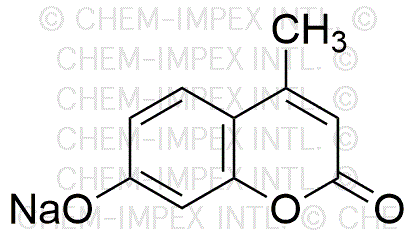4-Methylumbelliferone sodium salt is widely utilized in research focused on:
- Fluorescent Probes: This compound is often used as a fluorescent marker in biological assays, allowing researchers to visualize cellular processes and track biomolecules in real-time.
- Enzyme Activity Studies: It serves as a substrate for various enzymes, particularly in studies involving glucuronidation, helping scientists understand metabolic pathways and enzyme kinetics.
- Antioxidant Research: The compound is investigated for its potential antioxidant properties, making it relevant in studies aimed at combating oxidative stress in cells.
- Drug Development: Its role in inhibiting certain enzymes makes it a candidate for developing new therapeutic agents, particularly in cancer research where enzyme modulation is crucial.
- Cellular Imaging: Researchers use it in imaging techniques to enhance the visibility of cellular structures, aiding in the study of cell morphology and function.
Información general
Propiedades
Seguridad y normativas
Aplicaciones
4-Methylumbelliferone sodium salt is widely utilized in research focused on:
- Fluorescent Probes: This compound is often used as a fluorescent marker in biological assays, allowing researchers to visualize cellular processes and track biomolecules in real-time.
- Enzyme Activity Studies: It serves as a substrate for various enzymes, particularly in studies involving glucuronidation, helping scientists understand metabolic pathways and enzyme kinetics.
- Antioxidant Research: The compound is investigated for its potential antioxidant properties, making it relevant in studies aimed at combating oxidative stress in cells.
- Drug Development: Its role in inhibiting certain enzymes makes it a candidate for developing new therapeutic agents, particularly in cancer research where enzyme modulation is crucial.
- Cellular Imaging: Researchers use it in imaging techniques to enhance the visibility of cellular structures, aiding in the study of cell morphology and function.
Documentos
Hojas de datos de seguridad (HDS)
La SDS proporciona información de seguridad completa sobre la manipulación, el almacenamiento y la eliminación del producto.
Especificación del producto (PS)
La PS proporciona un desglose completo de las propiedades del producto, incluida la composición química, el estado físico, la pureza y los requisitos de almacenamiento. También detalla los rangos de calidad aceptables y las aplicaciones previstas del producto.
Certificados de análisis (COA)
Busque certificados de análisis (COA) ingresando el número de lote del producto. Los números de lote y de partida se pueden encontrar en la etiqueta de un producto después de las palabras "Lote" o "Lote".
Número de catálogo
Número de lote/lote
Certificados de origen (COO)
Este certificado de origen confirma el país en el que se fabricó el producto y también detalla los materiales y componentes utilizados en él y si se deriva de fuentes naturales, sintéticas u otras fuentes específicas. Este certificado puede ser necesario para cumplir con las normativas aduaneras, comerciales y regulatorias.
Número de catálogo
Número de lote/lote
Hojas de datos de seguridad (HDS)
La SDS proporciona información de seguridad completa sobre la manipulación, el almacenamiento y la eliminación del producto.
DownloadEspecificación del producto (PS)
La PS proporciona un desglose completo de las propiedades del producto, incluida la composición química, el estado físico, la pureza y los requisitos de almacenamiento. También detalla los rangos de calidad aceptables y las aplicaciones previstas del producto.
DownloadCertificados de análisis (COA)
Busque certificados de análisis (COA) ingresando el número de lote del producto. Los números de lote y de partida se pueden encontrar en la etiqueta de un producto después de las palabras "Lote" o "Lote".
Número de catálogo
Número de lote/lote
Certificados de origen (COO)
Este certificado de origen confirma el país en el que se fabricó el producto y también detalla los materiales y componentes utilizados en él y si se deriva de fuentes naturales, sintéticas u otras fuentes específicas. Este certificado puede ser necesario para cumplir con las normativas aduaneras, comerciales y regulatorias.


